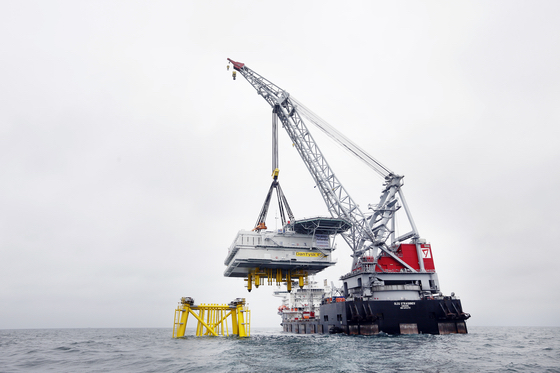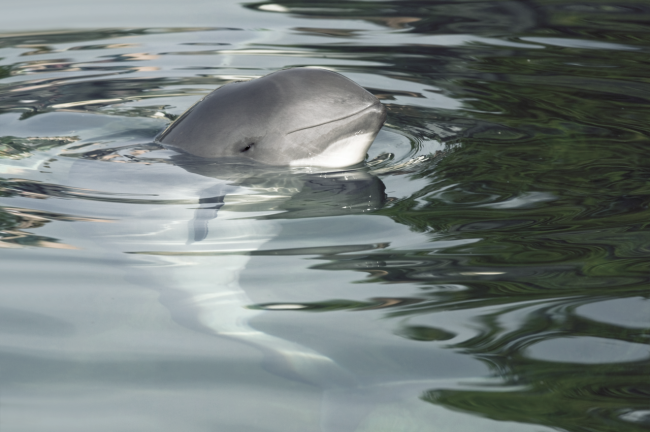Offshore wind power – for which the government stopped providing subsidies last year – is quickly becoming a major provider of green energy thanks to upscaling. Ireen Geerbex from Nuon/Vattenfall believes this is a strong stimulus for boosting renewables in the energy supply mix in the Netherlands.
The first Dutch offshore wind farm, NoordzeeWind, was commissioned in 2006, with the second following in 2008. At that time, offshore wind turbines were much more expensive than their onshore counterpart. An ambitious goal for offshore wind was ratified in the 2013 Energy Agreement: to have total installed capacity (the amount of power that can be generated in one year – Ed.) of 4,450 megawatts (4.5 gigawatts) in 2023. This is because there is more room for wind farms at sea than on land (the Dutch part of the North Sea is more than one and a half times as the country’s total surface area), although it was immediately noted that only limited space is available in the North Sea due to heavy shipping traffic.
This waterway is a favourable area for power generation with wind turbines due to relatively shallow water levels, favourable wind conditions and the proximity of harbours and power consumers (including industrial consumers). The goal of the Energy Agreement meant that subsidies were needed for additional offshore wind farms with a capacity of approximately 3,500 megawatts. Government agencies, NGOs and companies collectively agreed to reduce incurred costs for building wind farms by 40 per cent by means of innovations, upscaling and tight control of project expenditure. This task-setting cost reduction strategy was necessary to make offshore wind aspirations financially feasible.
Costs fell quicker than expected
The expectations regarding lower costs in light of the Dutch government’s subsidy programme that was set to expire were dramatically exceeded. While the Energy Agreement assumed cost reductions of 40 per cent in 2020 compared to 2013, cost reductions amounting to 70 per cent were actually achieved in 2018. This was proof of the suitability of the system chosen at that time, with the government issuing tender requests at regular intervals – if a company misses out on one, it can submit another one in fairly quick succession, meaning that a focus on offshore wind is certainly worthwhile – and providing the required licences, grid connections at no charge, and projects with sufficient scope. These assurances contributed to major cost reductions for offshore wind power, with the second unsubsidised tender process set to take place soon.
Unsubsidised wind farm
There are currently four wind farms in the Dutch North Sea area: NoordzeeWind (Nuon/Vattenfall and Shell) off the coast of Egmond aan Zee, Princess Amalia Wind Farm (Eneco) near IJmuiden, Luchterduinen (Eneco) near Noordwijk, and Gemini (belonging to a consortium led by the Canadian utility company Northland Power) nestled behind Schiermonnikoog. Together, this quartet can provide a capacity slightly below 1,000 megawatts. The additional planned capacity of 3,500 megawatts is intended to come from five larger wind farms yet to be built. The first will be the wind farms near Borssele, with construction expected to start in 2020. These wind farms will have a total capacity of 1,500 megawatts – enough power for about two million households. These tenders were the last in the Netherlands with a subsidy. In March of last year, Nuon/Vattenfall was selected to build the first unsubsidised offshore wind farm in the Netherlands: Hollandse Kust Zuid I & II. This wind farm will be situated more than 22 kilometres off the Dutch coast, in line with Leiden. According to the rules, this wind farm must be fully operational within five years. By September 2023 this wind farm, with a capacity of 750 megawatts, will be able to supply electricity for 1 to 1.5 million households. The invitation to tender for Hollandse Kust Zuid III & IV will be issued in March of this year, with Hollandse Kust Noord to follow by the end of the year according to government plans.
Stronger wind power turbines
Rapidly boosting the capacity of these new wind farms is crucial. The existing wind farms have capacities ranging from 200 to 300 megawatts, while the ones still to be built will have a much higher installed capacity (as much as five or six times). How is this possible? The main reason is that wind power turbines are becoming stronger and consequently deliver more green electricity at a lower unit cost. Current turbines deliver approximately 3 megawatts on average, while the turbines of the Borssele wind farm will have a capacity of 8 megawatts. Turbines that can deliver 15 megawatts with rotor diameters as wide as 200 metres are expected in the foreseeable future.
In essence, this upscaling means that fewer turbines are needed per wind farm. This results in less material, fewer boreholes and less installation and maintenance effort, as well as a lower rotor surface per wind farm – which is good for birds and bats. These scale advantages reduce the risk for energy companies seeking to operate wind farms. That is essential because revenue from wind farms will be uncertain in the absence of subsidies.
In time, the price of wind energy will drop as its availability increases It is therefore logical that energy companies and other operators are focusing on making further cost reductions. It helps here that players such as Nuon/Vattenfall have already accumulated extensive experience in building and operating offshore wind farms, including elsewhere in Europe. Their growing portfolio facilitates optimisation both in construction and other areas such as maintenance. Furthermore, Vattenfall – as a full-chain energy company – is increasingly driving the marketing of (unsubsidised) wind and solar power. It is clear that our customers are becoming increasingly interested in switching to green power.
There is also room for suitable action on the innovation front. For example, attention is already being given to the development of turbines that generate relatively more power at lower wind speeds, making revenue less dependent on times with high wind speed – which is important now because the supply is so large that the price is low. In addition, extensive research is being conducted into finding more efficient ways to link supply and demand, as well as ways to store electricity or convert it into other forms such as hydrogen.
Many more jobs
In the coming years, the Netherlands can benefit from these innovative developments for offshore wind. We are presently at the forefront of this movement, internationally speaking. A great deal of socially relevant knowledge in the field of power generation from offshore wind is being shared within Europe, such as environmental aspects.
The Cabinet wants to see new wind farms built in the North Sea between 2024 and 2030 with a capacity of just under 7 gigawatts in total, and perhaps even more if the Climate Agreement stimulates other sectors to increase the use of renewable energy. In that case, the new wind farms, together with other offshore wind farms, will have to deliver enough green power to cover approximately 45 per cent of our current total electricity consumption.
Construction of these wind farms will require investments in the multi-billion euro range, which will give a strong boost to the Dutch economy. It is estimated that construction of these wind farms will create 10,000 jobs in the period from 2024 to 2030.
There are even more ambitious plans for the years subsequent to this: offshore wind needs to be further expanded en route to creating a fully carbon-dioxide free energy supply; high voltage connections with neighbouring countries will be upgraded to increase grid capacity; and new offshore concepts will be developed. Various parties, including state-owned high voltage network operator TenneT, want to convert shallow areas of the North Sea into an enormous power island between 2030 and 2050, with an impressive 100,000 megawatts of installed capacity.
In addition, the demand for green electricity needs to evolve even faster to achieve the climate goals. Electrification and wind power will make transporting carbon dioxide neutral, our homes and offices will be heated with electricity, and industry will opt for electrification entirely in order to get away from fossil resources.
These ambitions must now be converted into concrete plans for tender processes from 2021 onward. Future-proof policy and concrete elaboration of the goals of the Climate Agreement form the basis for the Netherlands to take a leading role in offshore wind.
Article: Management Scope.




